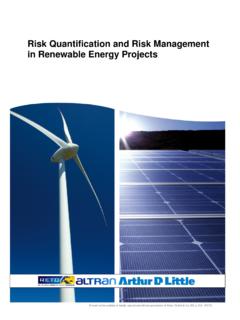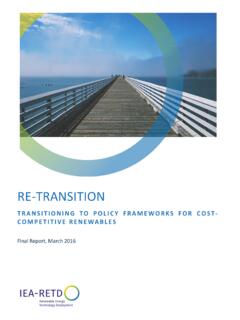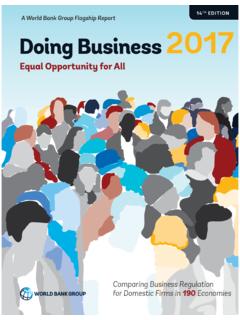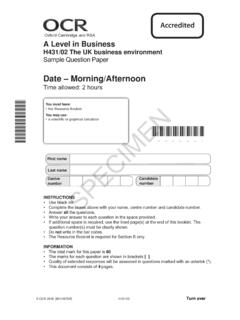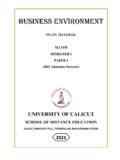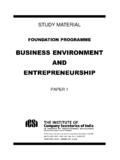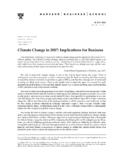Transcription of Business models for renewable energy in the built …
1 Business models for renewable energy in the built environment L. W rtenberger (ECN) Bleyl (Energetic Solutions) M. Menkveld (ECN) P. Vethman (ECN) X. van Tilburg (ECN) ECN-E--12-014 Updated version - April 2012 2 IEA-RETD / ECN-E--12-014 Acknowledgements This report presents the outcomes of the project Business models for renewable energy in the built environment (RE-BIZZ), initiated and funded by the IEA Implementing Agreement for Renew-able energy Technology Deployment (IEA-RETD). This project is registered at ECN under the num-ber The project report was first published in November 2011. It was updated in April 2012 with four additional case studies. Contact person for this publication at ECN is Laura W rtenberger The authors would like to thank the project steering group represented by Michael Paunescu (Nat-ural Resources Canada), Kjell-Olav Skj lsvik (Enova Norway), Milou Beerepoot (IEA Secretariat), Walt Patterson (Chatham House), David de Jager (Ecofys, IEA-RETD Operating Agent), Kristian Petrick (IEA-RETD Operating Agent) for their review and guidance during the course of the project.
2 A special thank you goes to Kristian Petrick, who was always available for feedback and valuable discussions. The authors would also like to thank Ron van der Steen from Financial Consult Neder-land for his helpful feedback and review, and Sytze Dijkstra at ECN for co-reading the report. Abstract The project RE-BIZZ aims to provide insight to policy makers and market actors in the way new and innovative Business models (and/or policy measures) can stimulate the deployment of renewable energy technologies (RET) and energy efficiency (EE) measures in the built environment . The pro-ject is initiated and funded by the IEA Implementing Agreement for renewable energy Technology Deployment (IEA-RETD). It analysed ten Business models in three categories (amongst others dif-ferent types of energy Service Companies (ESCOs), Developing properties certified with a green building label, Building owners profiting from rent increases after EE measures, Property Assessed Clean energy (PACE) financing, On-bill financing, and Leasing of RET equipment) including their or-ganisational and financial structure, the existing market and policy context, and an analysis of Strengths, Weaknesses, Opportunities and Threats (SWOT).
3 The study concludes with recommen-dations for policy makers and other market actors. About IEA-RETD RETD stands for renewable energy Technology Deployment . IEA-RETD is a policy-focused, tech-nology cross-cutting platform that brings together the experience and best practices of some of the world s leading countries in renewable energy with the expertise of renowned consulting firms and academia. IEA-RETD is a so-called Implementing Agreement, a platform where a number of countries cooperate under the framework of the International energy Agency (IEA). The mission of IEA-RETD is to accelerate the large-scale deployment of renewable energies (RE). This is achieved by providing information and recommendations on RE technology cross-cutting is-sues to policy makers and other stakeholders.
4 To this end, IEA-RETD commissions annually 5-7 studies performed by consultancies and academia. The reports and handbooks are publicly and freely available on the IEA-RETD s website at In addition, IEA-RETD organizes at least two workshops per year and presents at national and international events. IEA-RETD exists since 2005 and has currently 9 member countries (Canada, Denmark, France, Germany, Ireland, Ja-pan, Netherlands, Norway and the UK). IEA-RETD / Business models for renewable energy in the built environment 3 Contents 1. Introduction 10 Background 10 Scope of the report 10 Technological focus, market segments and country focus 10 How to define Business models for RET in the built environment 11 Reading guide and methodology 13 2.
5 Overcoming barriers for the deployment of renewable energy Technologies (RET) in the built environment 15 Current barriers 15 Market and social barriers 15 Information failures 16 Regulatory barriers 17 Financial barriers 17 Barriers from a Business case perspective 18 3. Business models for an increased deployment of RET in the built environment 21 Categorizing Business models 21 Product-service-system Business models 22 Business models based on new revenue models 23 Business models based on new financing schemes 24 4. Analysis of Business models 25 Product-Service Systems: energy -Contracting (ESCO or energy Efficiency Services) 25 Introduction, Definition and Common Key Features of all three ESCO models 25 energy Supply Contracting 30 energy Performance Contracting 33 Integrated energy Contracting 36 SWOT Analysis, Discussion and Conclusions for all three ESCO models 38 Business models based on new revenue models 43 Making use of a feed-in remuneration scheme 43 Developing properties certified with a green building label 49 Building owner profiting from rent increases after the implementation of energy efficiency measures 57 Business models based on new financing schemes 62 Property Assessed Clean energy (PACE)
6 Financing 62 On-bill financing 68 Leasing of renewable energy equipment 74 Business models based on energy Saving Obligations 80 5. Synthesis: Business models , barriers, market segments and actors 85 Which barriers are addressed by Business models ? 85 In which market segments can the Business models be applied? 88 Who are the actors involved in the Business models ? 90 Conclusion and further considerations 92 Conclusions 92 Further considerations 93 Potential for further research 97 6. Recommendations for policy makers and market actors 99 Recommendations for policy makers 99 Recommendations for building owners 103 Recommendations for other market actors 103 Appendix A Case studies 105 4 IEA-RETD / ECN-E--12-014 LIG, Austria - Integrated energy -Contracting Pilots 105 Berkeley FIRST - the first PACE financing programme 107 Financing commercial building retrofits with the help of an Environmental Upgrade Charge in Melbourne 108 PROSOL: Supporting market growth of solar water heating in Tunisia 109 Greenchoice.
7 Solar supply contracting in the Netherlands 111 Adaptation of the rental price evaluation system in the Netherlands 112 Market introduction of small and micro CHP systems 114 Leasing of a heat pump system 115 energy supplier obligations in the UK 116 Power Smart Residential Loan programme of Manitoba Hydro, Canada 118 LEED certification 119 Berlin energy Saving Partnership 121 IEA-RETD / Business models for renewable energy in the built environment 5 List of tables Table Barriers and market segments 19 Table List of analysed Business models 22 Table Barriers addressed by the Business models 86 Table Market segments addressed by the Business models 89 Table Actors directly involved in the various Business models 91 Table Sample calculation for the installation of a solar PV plant on a residential building under the pilot Berkeley FIRST PACE financing programme 107 List of figures Figure Scope of services of different ESCO models 23 Figure energy -Contracting.
8 A modular energy service package with guaranteed results for the client. (Note: The added value for the client of energy contracting compared to in-house implementation is displayed in red.) 26 Figure energy -Contracting: Components of service package and outsourcing of interfaces and guarantees to an ESCO 27 Figure energy -Contracting model where building owner finances RET equipment through a loan from a financial institute 28 Figure energy -Contracting model where ESCO finances RET equipment (optionally with financial institute) 28 Figure ESC- model : Schematic standard scope of services including renewables 30 Figure energy Supply-Contracting Business model 31 Figure EPC- model : Schematic standard scope of services 33 Figure energy Performance-Contracting Business model 34 Figure IEC- model .
9 Schematic standard scope of services 36 Figure Integrated energy -Contracting Business model 37 Figure energy -Contracting models : summary of SWOT analysis 40 Figure Value chain from primary energy to energy services 41 Figure Schematic depiction of a Business model based on a feed-in tariff and production exceeding own use, smart meter optional 45 Figure Schematic depiction of a Business model based on a feed-in premium and production less than own use, smart meter optional 45 Figure Business model based on feed-in remuneration - summary of the SWOT analysis 47 Figure Schematic depiction of the Business case of developing a property certified according to a green label 51 Figure Countries with green building certification programs 52 Figure Voluntary green building certification - summary of the SWOT analysis 55 Figure Schematic depiction of the Business model 58 Figure Business model based on higher rents after improving energy performance of a building - summary of the SWOT analysis 60 Figure Schematic depiction of PACE financing for RET 62 Figure PACE financing - summary of the SWOT analysis 66 Figure Schematic depiction of on-bill financing of RET 69 6
10 IEA-RETD / ECN-E--12-014 Figure On-bill financing - summary of SWOT analysis 72 Figure Lease agreement without involvement of an ESCO 75 Figure Lease agreement with involvement of an ESCO 75 Figure Leasing arrangement between a company distributing a specific technology and a building owner 76 Figure Leasing of RET - summary of the SWOT analysis 79 Figure Schematic depiction of energy Saving Obligations, depicting one building owner who profits from the obligation by lower energy prices after an installation of RET / EE measure and another building owner who only pays a higher price for his electricity. 81 Figure energy Saving Obligation - summary of the SWOT analysis 84 Figure Schloss Retzhof : Seminar House of the Province of Styria 105 Figure Organisational structure of the PROSOL Business model 110 Figure Net costs and benefits of renovation for landlords and tenants, under the adapted rental price evaluation system 113 List of boxes Box Case in point: Berkeley FIRST - the first PACE financing programme 68 Box Case in point: PROSOL 73 Box Case in point: Market introduction of small and micro CHP systems 80 Box Case in point: Wonen++ concept an example of small scale energy services 95 Box Case in point.
